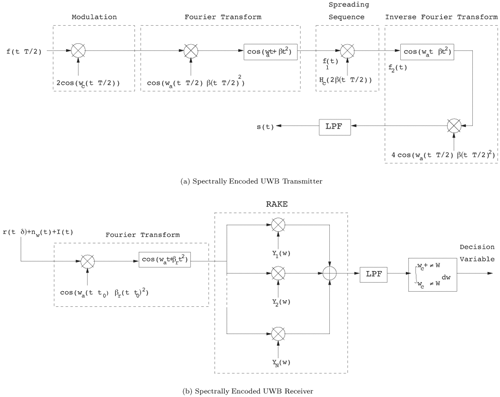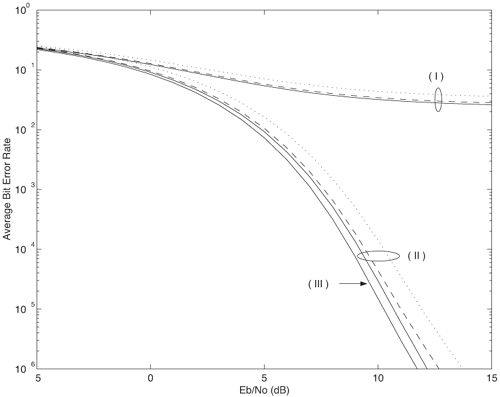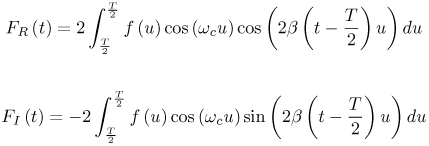Section 6.3. Spectral Encoded UWB Communication System
|
6.3. Spectral Encoded UWB Communication SystemIn this section, we describe a UWB communication system that uses spectral encoding as a multiple access scheme with interference suppression capability [78]. The main advantage of this technique is that the transmitted signal spectrum can be conveniently shaped to suppress narrowband interference. The concept of spectral coding has been proposed both in an optical communication system in [79, 80] and for a wireless communications scenario [81, 82]. In this technique, a message signal is multiplied by a spreading sequence in the frequency domain, as opposed to conventional direct sequence code division multiaccess systems in which the encoding is in the time domain. As a result, the signal will be spread in time. Multiaccess capability is achieved by assigning distinct spreading sequences to different users. When narrowband interference suppression is desired, a spreading sequence is used that has a spectral null where the narrowband interference is located. Moreover, the narrowband interference is "notched out" at the receiver when the received signal spectrum is multiplied by the conjugate of the transmitted signal spectrum (correlation receiver). See [83] for implementation details. Fourier Transform of the data signal is performed by a well-established implementation that corresponds to the multiplication and convolution of the desired signal by chirp (linear FM) waveforms using surface acoustic wave (SAW) devices. SAW devices have evolved to the GHz range, and currently submicron manufacturing and material techniques are improving greatly to frequencies up to 10 GHz. A schematic of the transmitter is shown in Figure 6.53a.[3] The modulated signal f (t) is a real and even function and is only nonzero in
Equation 6.146 where wa, b are respectively the center frequency and half slope of the chirp signals, and FR (t), FI (t) are respectively the real and imaginary components of the Fourier Transform of the modulated signal f (t), and are given by Equation 6.147 where wc is the carrier frequency. f1 (t) is valid only in t Equation 6.148 Figure 6.53. Block Diagram of Spectrally Encoded UWB Transmitter and Receiver. where PN (w) is in general a complex waveform bandlimited to Equation 6.149 The output transmitted signal s (t) is the inverse Fourier Transform of the signal f2 (t) and is equal to Equation 6.150  where R(w) and I (w) are defined as R(w) = FR (w)PNR (w) and I (w) = FR (w).PNI (w). W is the bandwidth of the signal f (t). The transmitted signal is valid only in t Equation 6.151 where Equation 6.152 for m = 1, 2, . . ., N and am is the channel gain. A rigorous analysis of the receiver with numerical approximations and system performance curves is presented [78]. Figures 6.54 and 6.55 show the performance gains for this novel receiver structure. This method of spectrally encoding the UWB signal can suppress narrowband interference and create spectral nulls where desired, simplifying the requirement to meet the FCC mask. Figure 6.54. Average Bit Error Rate. (The decision is based on the first 10 received multipath components. The SIR is equal to 5 dB (dotted lines), 10 dB(dashed), and 15 dB(solid): (I) no interference suppresstion, (II) interference suppression, and (III) no interference).SOURCE: C. R.C.M. da Silva and L. B. Milstein, "Spectral-Encoded UWB Communication Systems," IEEE Conference on Ultra-Wideband Systems and Technologies [78]. © IEEE, 2003. Used by permission.  Figure 6.55. Average Bit Error Rate. (The decision is based on the first 20 (solid lines), 10 (dashed), and 5 (dotted) multipath components with largest absolute values, among the first 20 multipath components. The SIR is equal to 10 dB. (I) no interference suppression, (II) interference suppression, and (III) no interference with first 20 received multipath components considered).SOURCE: C. R.C.M. da Silva and L. B. Milstein, "Spectral-Encoded UWB Communication Systems," IEEE Conference on Ultra-Wideband Systems and Technologies [78]. © IEEE, 2003. Used by permission.  |
|
EAN: 2147483647
Pages: 110
- Chapter I e-Search: A Conceptual Framework of Online Consumer Behavior
- Chapter II Information Search on the Internet: A Causal Model
- Chapter VI Web Site Quality and Usability in E-Commerce
- Chapter VIII Personalization Systems and Their Deployment as Web Site Interface Design Decisions
- Chapter IX Extrinsic Plus Intrinsic Human Factors Influencing the Web Usage




